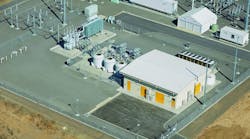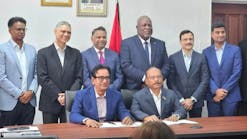In late June 2019, in Germany, Siemens celebrated the installation of its 100th STATCOM.
STATCOM is an abbreviated form of the term ’static synchronous compensator‘ — devices designed to mitigate voltage disturbances on today’s transmission networks. STATCOMs are particularly relevant today, with the ever-increasing incorporation of inverter-connected generators tied to wind and solar power.
T&D World spoke with Mirko Duesel, head of Transmission Solutions at Siemens, and Ludger Meier, head of Operations and Engineering in the German grid operator Amprion, about transmission network changes over the past few years.
T&D World: Let’s talk about the German energy transition and its impact on the German grid.
Duesel: Originally we built grids with generation as close as possible to the consumer. Those were the days of coal plants and nuclear plants within the region of the cities where you would have the most use for that energy.
Now and for the future we have more of the challenge to limit carbon dioxide emissions.
Renewable energy is the answer, but this is usually not in places that are as near the cities. One answer to solve this problem was to find optimal places where the wind blows, and that is offshore. The difficulty was we had the wind farms offshore but how would we get the energy to the people who needed it? In this case our grid access solutions such as high-voltage direct-current (HVDC) ensured that power was delivered to shore with minimal loss.
Germany will cease use of nuclear power by 2022. The nuclear plants are mostly located in the southern part of the country. In the future, renewable power will have to be transmitted from the north of Germany to the cities in the south. This has necessitated changing the transmission system as it was not orginally designed for such long distances. For this reason, volt-ampere reactive (VAR) compensators have been added to ensure power supply from the north to the southernmost parts of the country. A similar situation exists in California. There our customers have used STATCOM, where you have a lot of renewable generation, a very large grid, huge distances, and fewer people.
Meier: The challenge for grid operators is that energy production is volatile. When you operate overhead lines with high load and low load you need VAR compensation. Reactive power can be inductive or capacitive in a huge amount. Those differences get magnified because the transmission distances are increasing. We are really glad that we have a supplier like Siemens that supports us with modern and newer technology. The STATCOM is a very flexible system that helps us to do this.
T&D World: Looking at transmission networks worldwide, are the challenges in other countries or continents similar?
Duesel: [In Germany] we have very dense population, and in dimensions it is a very narrow country. We learned there to react in short distances to keep the stability of the grid. We see different challenges in other parts of the world. The challenge is always the same as to how to get a stable voltage level and power supply, but in the United States, there are very different ideas on how to do this. In Texas, you have very low density, while in New England the networks can be very dense and complex.
In Brazil, most people live on the coasts, while power generation is in the rain forests. The power is generated in the north, far away from where it needs to be moved to the cities.
In Chile, you also have long distances, along with high altitude. The generation is in the far north and far south, so you have the same story. The population lives in-between.
In India, you have an enormous population but some don’t have access to electricity. It is much easier to stabilize the existing network than to build a new line, because it is so crowded. Every country has a different situation but we all need the stabilization.
Meier: We have a very highly reliable grid [in Germany], and therefore we have no outages as such because that is a no-go. We have electrical disturbances, but they do not lead to system breakdown as we now see in South America.
You cannot lose electricity — we are keen on having enough controlled capacity for VAR compensation in our own hands so we can balance it flexibly on hand.
T&D World: What about the opportunities and challenges via digitalization and electrification, for instance the influx of electric vehicles (EVs)?
Meier: The challenge is that we have to modernize even our existing grid. Demand for electricity is increasing, so control software and hardware have to be updated. The mobility of electrification is not as big a concern for us as it is for distribution. When EVs are charged, it is against a fixed installation. That may make it not as easy for distribution operators to predict where the load will increase, but it doesn’t affect transmission as much.
Duesel: The basic challenge is how do we keep it affordable to run our grid? How much investment do we need and how do we drive an increase in use? How do we forecast the patterns? Also, how do we react quickly? STATCOM can read it automatically. In order to increase reliability, how do we make sure that the control stays with us and nobody else gets into the system? Step by step we are improving.
STATCOM increases the efficiency of the grid. We also put STATCOM on wheels to make it mobile. In the past, when hurricanes destroyed a part of the grid, it took six to eight months to rebuild it. We can boost capacity of a grid much faster using a mobile STATCOM. The network can be rebuilt faster with more capacity — a very good interim solution for storms.
T&D World: What do you see in the future?
Meier: We see that we will have an increasing demand for VAR compensators, as well as increasing electronics to get the grid really working well.
Duesel: We are talking more and more about cities and more people living in cities. We see less and less acceptance for building new infrastructure, so this is one driver and the other driver is reducing investments to keep electricity affordable.
The third driver is renewables are making it harder to forecast generation. With power electronics, we can better adapt to fluctuations in generation.


